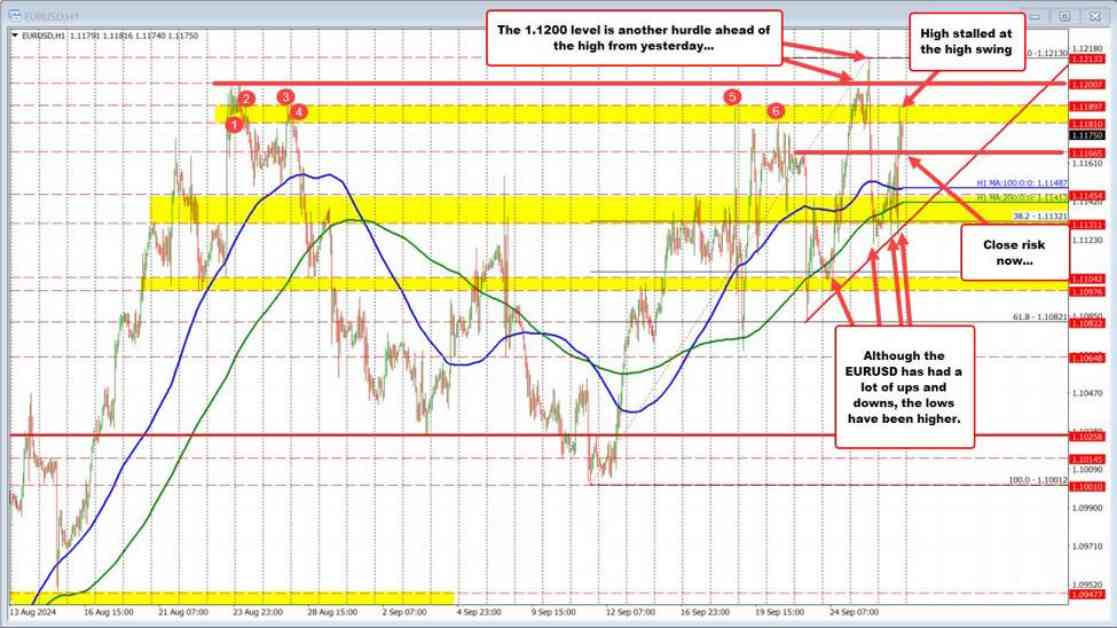EURUSD Price Approaches Resistance Level in Forex Trading
The EURUSD pair experienced a day of volatile price action, with fluctuations that kept traders on their toes. The price moved above and below the 100/200 hour moving averages (MAs), reflecting uncertainty among buyers and sellers in the forex market. In a morning video update, analysts discussed this market dynamic, with a slight nod given to the buyers due to higher lows and the price being above the 100/200 hour MAs at the time.
As the day progressed, the pair initially moved lower and fell below the 100/200 hour MAs, but managed to stay above the European morning low. Subsequently, the price rebounded and made a final push above the MAs, signaling a convincing move by the buyers to push higher. This upward momentum led the EURUSD pair to test a swing area defined by previous swing highs from August 23 to August 27. Last week, the pair revisited this same area, which falls between 1.1181 and 1.11897.
On the first test of the upper extreme from the swing area at the 1.11897 level, sellers stepped in and tried to stall the rise. However, the price only experienced a modest pullback since then. Traders now find themselves at a crossroads, wondering if the recent run to the swing area will result in a rotation back to the downside, as seen in previous patterns, or if this could be the breakout moment that leads to further upside momentum.
One positive aspect for traders is the ability to use 1.11897 as a key level to define risk and bias. Buyers looking to enter the market can sell with a stop order placed above 1.11897, with targets set at 1.1200 and the high from the previous day. On the other hand, sellers can take advantage of the current resistance level and aim for a move back below key support at 1.1166, targeting the 100 and 200 hour MAs at 1.11487 and 1.11413, respectively. Maintaining a position below these MAs is crucial to reinforce the bearish bias.
While buyers have been gaining momentum, the question remains whether this upward trend can be sustained. Breaking and staying above 1.11897 would instill more confidence in the buyers and potentially lead to further gains in the EURUSD pair. Traders are advised to closely monitor price movements and key levels to make informed trading decisions in this volatile market environment.
Factors Impacting EURUSD Price Movement
Several factors can influence the price movement of the EURUSD pair in forex trading. One major factor is economic data releases from the Eurozone and the United States, which can impact the strength of the euro and the US dollar. Positive economic indicators such as strong GDP growth, low unemployment rates, and rising consumer confidence can boost the value of the euro relative to the dollar, leading to an increase in the EURUSD exchange rate.
Geopolitical events and global economic trends also play a significant role in shaping the direction of the EURUSD pair. Political instability in the Eurozone or the US, trade disputes between countries, and changes in monetary policy by central banks can all contribute to fluctuations in the currency pair. Traders must stay informed about these developments to anticipate potential market movements and adjust their trading strategies accordingly.
Technical analysis is another important factor that traders consider when analyzing the EURUSD price chart. Moving averages, support and resistance levels, chart patterns, and other technical indicators help traders identify potential entry and exit points for their trades. By combining technical analysis with fundamental analysis, traders can develop a well-rounded trading strategy that takes into account both market sentiment and price trends.
Overall, the EURUSD pair remains sensitive to a variety of factors that can impact its price movement. Traders must stay vigilant and adapt to changing market conditions to navigate the complexities of forex trading successfully.
Strategies for Trading the EURUSD Pair
When trading the EURUSD pair in the forex market, traders can employ a variety of strategies to capitalize on price movements and maximize profits. Here are some common strategies that traders can consider:
1. **Trend Following**: One popular strategy is trend following, where traders seek to profit from the prevailing direction of the market. By identifying the current trend using moving averages or trendlines, traders can enter long or short positions to ride the trend until it reverses. This strategy requires patience and discipline to follow the trend and avoid premature exits.
2. **Range Trading**: Range trading involves identifying key support and resistance levels where the price tends to fluctuate within a defined range. Traders can buy at support and sell at resistance, aiming to profit from the price bouncing between these levels. This strategy works well in sideways markets where the price lacks a clear trend.
3. **Breakout Trading**: Breakout trading involves entering a trade when the price breaks above or below a significant level of support or resistance. Traders anticipate a strong momentum move following the breakout and aim to capture profits as the price continues in the breakout direction. This strategy requires quick decision-making and risk management to capitalize on breakout opportunities.
4. **News Trading**: News trading involves reacting to economic data releases, central bank announcements, and geopolitical events that can impact the currency pair. Traders can take advantage of the volatility generated by these events to enter high-probability trades based on the news outcome. This strategy requires fast execution and a deep understanding of how news events influence market sentiment.
5. **Scalping**: Scalping is a short-term trading strategy that focuses on making quick, small profits from rapid price movements. Traders enter and exit trades within minutes or seconds, aiming to capture small price fluctuations multiple times throughout the day. This strategy requires a high level of concentration and fast execution to capitalize on fleeting opportunities.
By incorporating these strategies into their trading approach, traders can adapt to different market conditions and enhance their chances of success when trading the EURUSD pair. It’s essential for traders to test these strategies in a demo account before applying them to live trading to refine their skills and improve their decision-making abilities.

















